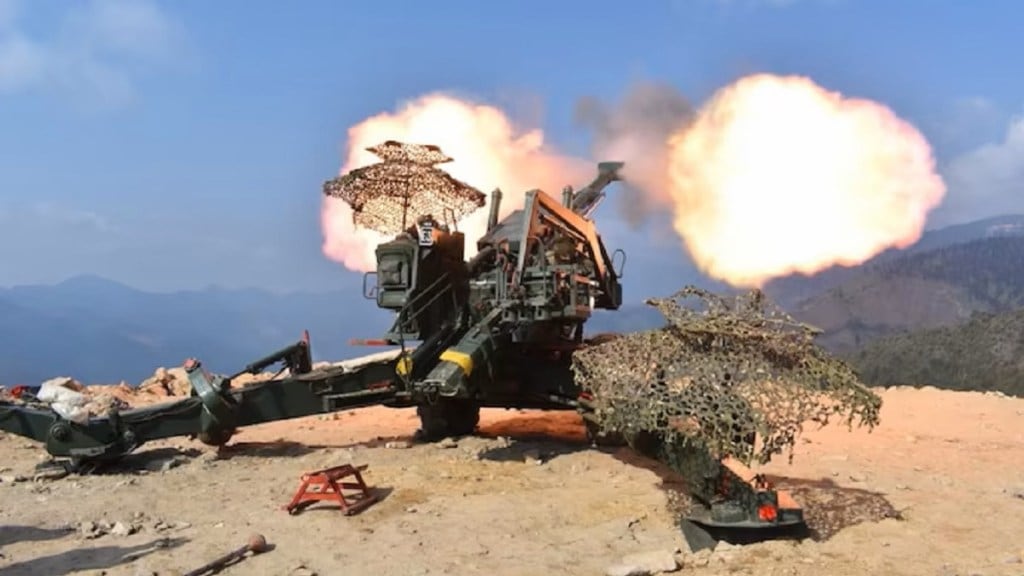An integrated surveillance and firepower training exercise ‘Buland Bharat’ was conducted in the eastern theatre’s recently operationalised longest high-altitude Artillery Ranges.
Frontier troops and equipment were tested in simulated war conditions in high-altitude areas and extreme weather conditions during which synergised surveillance and firepower from Infantry and Artillery radars, weapon systems and direction of fire from the air were practised.
Bringing the full might of artillery, the army fired various large caliber 155 mm artillery guns including 155 mm Bofors howitzers, M-777 Ultra-light howitzers, 105mm field guns and 120mm mortars.
The former army chief said that the army planned its firepower in the high-altitude areas of Arunachal Pradesh, indicating the highest level of operational readiness in case of any eventuality.
That indication hints at the Chinese aggression across the Line of Actual Control (LAC) in Arunachal Pradesh.
The exercise involved the synergised application of surveillance and firepower capabilities of the Artillery and the Infantry in close coordination with Special Forces, Aviation and Central Armed Police Forces (CAPF) deployed in West Kameng and Tawang districts of Arunachal Pradesh.
The deployment of a wide array of artillery weapons along the entire 3,488-km-long Line of Actual Control (LAC) is now part of such high-voltage combat exercise. Tawang sets forth a wave of new military drills with a new approach. The tactical shift is all about the no-holds-barred, high-voltage combat exercise with the full might of artillery and infantry on the offensive with air power.
What is the tactical shift in military drills?
Infantry’s tactical approach
The exercise ‘Buland Bharat’ comes right after the multi-domain exercise with the strategic forces of the Indian Army and the Air Force carried out in strategically key areas in the Eastern sector.
The joint military exercise took place last month in the backdrop of Beijing announcing Chinese names for 11 more places in Arunachal Pradesh. What is often dubbed as the whimsical move of China, which claims Arunachal Pradesh as the southern part of Tibet.
Earlier as a part of the drills, the IAF deployed C17 Globemaster aircraft, Chinooks and Mi 17 choppers for conducting multi-mode insertion operations into designated greenfield landing zones with surgical precision.
While the highly intense war exercise makes of multi-layer complex coordination, troops mobilization and gun deployment, its message is quite simple and straight – critical offensive against the aggressor.
That is exactly what the Indian armed forces is planning to do through exercise ‘Buland Bharat’ with the Indian army leading the ground attack.
The exercise actually aimed to show the speed, agility and lethality of the specialised troops and their ability to rapidly deploy into a hostile environment, secure landing zones and engage the enemy with precision and speed as per the tactical setting.
However, the fact that the exercise involved the synergised application of surveillance and firepower capabilities of the Artillery and the Infantry in close coordination with Special Forces, Aviation and Central Armed Police Forces (CAPF) has redefined the new tactical approach and strategic goals.
“This is a steep learning curve that the Indian army is known for its progressive assessment over the time and experiencers gained,” explained the former Chief.
He adds: “Certainly, the Indian army edges over in terms of its preparation with precise movement and counter-offensive.”
The offensive and the counter-offensive readiness is much visible with the fast deployment of the newly acquired Russian S-400 Triumf surface-to-air missile system behind the Line.
The PLA’s planning
On the other side, China’s People’s Liberation Army has been conducting military drills at a higher altitude. The drills mostly take place in Tibet Military District at an altitude of 4,700 metres (15,400 feet).
The military exercise often involved infantry, artillery, army aviation, special operation forces, electronic warfare, engineers, and special defence units (Chemical units).
The PLA often tested the long-range rocket launchers to stage precision strikes—mostly the newly launched ones. For example, last year, the PLA tested its Type PHL-03 multiple-launch rocket system and PCL-181 vehicle-mounted howitzers. That largely shows the efficacy of its arsenal against India; so much so that more than 50 new weapon systems and guns have been deployed by the PLA to the area post-Galwan standoff with India.
At the same time, China has permanently deployed its air defence missile systems. Besides the land forces, the People’s Liberation Army’s Air Force (PLAAF) has also permanently stationed its J-20s at the Hotan airbase in China’s Xinjiang province with a set of bombers. Both Xinjiang and Tibet are under the Chinese Western Theatre Command that overlooks the LAC with India.
That all leads to the tactical shift towards combat-ready military drills which the Indian army has been testing with its full force of artillery and infantry together with IAF.
The exercise ‘Buland Bharat’ demonstrated that firepower, with offensive and defensive forces to confront and neutralize China’s “Anti Access Area Denial (A2AD)” policy.

